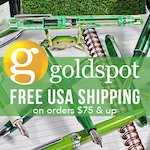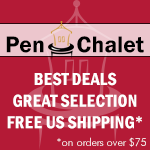(Jeff Abbott is a regular contributor at The Pen Addict. You can find more from Jeff online at Draft Evolution and Twitter.)
There's a blurry line between what qualifies a regular fountain pen as a luxury fountain pen, and it usually boils down to the eye of the beholder. After a certain price point, it becomes a subjective notion of how the pen makes you feel and other qualifications you grant it based on your own perceptions and experiences. There's plenty of times that I've looked at a pen that cost several hundred dollars and thought the pen didn't quite live up to the price. After all, it's just a pen, right? Sure. Then, you pick the pen up and start writing with it, and that price suddenly begins to match up with your perceptions.
The Aurora Nikargenta 88 Small is a fountain pen designed after a prestigious 1950s design that oozes class and elegance. From a distance, this pen looks like an average fountain pen, but it's anything but that. Every detail is covered and the writing experience is wonderful straight from the box. When I first handled the pen, I wasn't sure it would win me over. After inking it up and writing a few lines, it almost immediately found a permanent place in my lineup. Writing with this pen is pure joy.
Aesthetics
The Nikargenta 88 Small is a petite pen that sports a classic shape. I think the design is beautiful and timeless, and I think a lot of people agree. When handling the pen, it feels solid and well-made. There's no doubt in my mind that this pen would last a lifetime or more. The piano black finish and bright chrome trim make a statement that's hard to deny. Aurora did a great job with branding the pen — "Aurora" is imprinted on the cap band in a nice script. Apart from that, there is no other prominent branding. There's the scroll work on the nib, but that's normal for every pen maker. There is no etching or other markings on the pen.
The clip is stronger than it looks. In a lot of cases, it requires two hands in order to clip it on to a thick bag or case. Shirt pockets are no problem, though.
It's also surprisingly light, which is a great feature when writing. I'm not sure why I expected to be hefty, but I was happy to find the opposite was true.
The cap is a pressure fit, which means there are no threads on the section or body. For a sleek pen like this, that's a perfect design decision. I love the fact that there aren't any visible threads on this pen. Also, the friction on the cap is perfect — not too loose or tight.
Writing experience
This pen is an absolute joy to write with. The nib on this particular unit is a medium point, and it's smooth as silk. When writing with the pen, the plastic grip section provides a great feel and I haven't noticed any discomfort when using it for longer writing periods.
The feed system on this particular pen is astounding. It can deliver plenty of ink to the nib, which leans on the wetter side. I've a had a couple of incidents involving ink spitting out if the pen is uncapped quickly, but in normal use this wasn't a problem. Any pen with a wet feed is prone to hiccuping ink if slung around. There's never any skipping or slow starts with this pen — it's ready to go as soon as you are, and it keeps up with the fastest pace with ease.
The nib tuning is smooth and efficient. Apart from a more custom grind that I might prefer, this nib is perfect out of the box. The nib is made of 14k gold and features elegant scroll work along with the Aurora name and a "14K" stamp.
Writing with the pen is the exact subjective experience I mentioned above that elevates a normal fountain pen into the upper luxury price ranges. This pen feels luxurious, and it makes the price tag seem fair.
The nib is exceptional for writing purposes, and it also has a fair bit of flex if you apply moderate pressure. Nothing like a truly flexible nib, but more than you'd expect from a normal gold nib. It's definitely a good nib for showcasing inks that shade well.
You can use cartridges or the included cartridge-converter with this pen. The converter holds a good amount of ink, comparable with the Lamy size. It's a mixture of plastic and metal materials, which lines up with the overall price point of the pen.
Overall
The Nikargenta 88 Small follows a specific aesthetic design that you can find in other fountain pens, but I'd wager that you'll have a hard time finding another pen with equal quality and attention to detail as this one. For a luxury pen, it's on the lower side of the price scale, coming in around $350 at online retailers and $550 at full suggested retail. While not cheap, it's an incredible value for such an elegant and lovely pen. If you're in the market for a nice petite pen that features a timeless design, add this one to your list.
(Kenro Industries provided this product at no charge to The Pen Addict for review purposes.)
Enjoy reading The Pen Addict? Then consider becoming a member to receive additional weekly content, giveaways, and discounts in The Pen Addict shop. Plus, you support me and the site directly, which I am very grateful for.
Membership starts at just $5/month, with a discounted annual option available. To find out more about membership click here and join us!




























